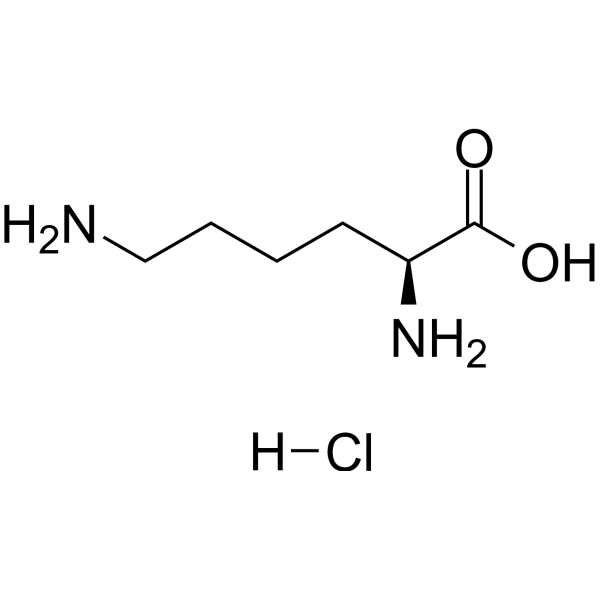Home
Products
L-(+)-Lysine monohydrochloride



| Product Name | L-(+)-Lysine monohydrochloride |
| Price: | Inquiry |
| Catalog No.: | CN00661 |
| CAS No.: | 657-27-2 |
| Molecular Formula: | C6H15ClN2O2 |
| Molecular Weight: | 182.6 g/mol |
| Purity: | >=98% |
| Type of Compound: | Alkaloids |
| Physical Desc.: | Powder |
| Source: | |
| Solvent: | Chloroform, Dichloromethane, Ethyl Acetate, DMSO, Acetone, etc. |
| SMILES: | NCCCC[C@@H](C(=O)O)N.Cl |
| Contact us | |
|---|---|
| First Name: | |
| Last Name: | |
| E-mail: | |
| Question: | |
| Description | L-lysine hydrochloride is an essential amino acid for humans with various benefits including treating herpes, increasing calcium absorption, reducing diabetes-related illnesses and improving gut health. |
| In Vivo | L-lysine treatment attenuates pancreatic tissue injury induced by L-arginine by inhibiting the release of the inflammatory cytokine IL-6 and enhances antioxidant activity. Pre- or post-treatment with L-lysine leads to significant decreases in the levels of malondialdehyde and nitric oxide, while significant enhancement is observed in the activities of antioxidant enzymes (superoxide dismutase, catalase, and glutathione peroxidase) and glutathione[1]. L-lysine supplementation almost completely ameliorates vascular calcification. Dietary L-lysine strongly suppresses plasma intact parathyroid hormone in adenine rats and supports a proper bone-vascular axis. The conserved orientation of the femoral apatite in group Lys also evidences the bone-protective effects of L-lysine. Dietary L-lysine elevates plasma alanine, proline, arginine, and homoarginine but not lysine[2]. The dose-dependent delay in gastric emptying observed in rats is confirmed in humans with an increase in halftime of gastric emptying of 4 min/g L-lysine. Moreover, a dose-dependent increase in intestinal fluid accumulation is observed (0.4 mL/min/g L-lysine)[3]. |
| Animal Admin | Rats: Nephrocalcinosis in 6-week-old male Wistar rats is induced by continuous injection of rat PTH 1-34 at a dosage of 40 μg/kg per day via an osmotic mini-pump for 50 hours. L-lysine HCl or glycine at a dose of 20 mmol/kg is administered via a gastric tube at 2 hours, 14 hours, 26 hours, and 38 hours after the implantation of the osmotic pump. At the indicated periods, Serum and urinary biochemical parameters, urea nitrogen, albumin, calcium, inorganic phosphate, and magnesium are determined by clinical diagnostic reagents[2]. Mice: Four groups of mice (10 in each group) are assessed. Group I is the control. Animals in groups II-IV are injected intraperitoneally with L-arginine hydrochloride (400 mg/kg body weight [bw]) for 3 days. Group III animals are orally pre-treated with L-lysine(10 mg/kg bw), whereas group IV animals are orally post-treated with L-lysine(10 mg/kg bw). Serum samples are subjected to amylase, lipase, transaminase, and interleukin-6 (IL-6) assays. The pancreas is excised to measure the levels of malondialdehyde, nitric oxide, catalase, superoxide dismutase, reduced glutathione, and glutathione peroxidase[1]. |
| Boiling Point | 311.5ºC at 760 mmHg |
| Flash Point | 142.2ºC |
| Exact Mass | 182.082199 |
| PSA | 89.34000 |
| LogP | 1.72990 |